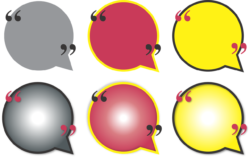Hey! Where Are the Quotation Marks?
 Image by Mary Pahlke from Pixabay
Image by Mary Pahlke from PixabayI can’t remember what I did yesterday, but I can remember exactly where I was sitting at a Redwood Writers (CA) workshop when I learned that some writers do not use quotations around dialogue. Actually, at this time one author was mentioned, whom I had not heard of. I think this particular author used a hyphen or short dash at the beginning of lines of dialogue. I thought, “Oh, the horror!” And life went on . . .
Several months ago, I read The Lincoln Highway by Amor Towles. Excellent book. But I noticed there were no quotation marks to indicate dialogue. This was the first time I noticed I was reading something without quotation marks to indicate dialogue. I don’t think there were dashes either. Just — nothing.
Nonetheless I could read the book easily, and the lack of quotation marks did not bother me at all. Actually, it felt rather freeing not to have all those little marks in there. Shortly after I finished reading it, I spoke to a friend who was in the process of reading it. She didn’t even notice it had no quotation marks to indicate dialogue. At the time I figured it was because she was not involved in writing or publishing.
When I was researching this post, I discovered that there are many books that don’t use quotation marks for dialogue — some of which I have read without ever noticing. And a few of them I read recently.
Some of the more famous authors who don’t use quotation marks for dialogue are Samuel Beckett, Cormac McCarthy, E.L. Doctorow, and the forefather of this style, James Joyce (whom I read a while ago and choose to forget about).
A few of the books I have read and never noticed they were “quoteless” are Normal People by Sally Rooney, Groundskeeping by Lee Cole, and Girl, Woman, Other by Bernadine Evaristo (all of which I liked).
In the beginning, 1st-century scribes used the diple (>) to indicate a line containing noteworthy text. After the invention of the printing press, compositors used a pair of commas – or hanging commas – to indicate quoted text. Quotes have been in print since the 16th century.
However, not all countries and languages use the double quotes for dialogue. In the United Kingdom single quotes are used, with double quotes used for quotes inside of quotes — exactly the opposite of how we in America do it. In France it is customary to use dashes.
So, why not use quotation marks to indicate dialogue? Most authors (including me) still do.
Some say eliminating the quotes is more elegant and actually easier for readers.Lack of quotation marks blurs the line between dialogue and description, allowing readers to insert more of their own interpretation.If you write well, the reader should be able to easily tell the difference between text and dialogue.The page looks cleaner without all the little marks.However, if not done correctly, the lack of quotation marks can be a problem.
It can be annoying to the reader trying to figure out who is saying what.It is not the reader’s job to determine what is dialogue and what isn’t. Therefore, some readers might just give up.
…And then there is e.e.cummings and his lack of capital letters. But that’s another thing entirely . . .



